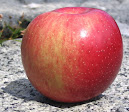
|
Margil was recently identified as a parent of the great Cox's Orange Pippin, upending a century of conventional wisdom.
I was especially curious to try this apple.
These are conical and ribbed, and not always symmetrical. Medium to large. There's a promising aroma
My Margils have a painterly mix of blush, a fine russet, and bare peel, all variations on an orange theme. Indeed it is hard to tell where the russet ends.
The blush is patchy but there are a few vertical bands that are quite saturated.
The apple has a matte finish, which makes it even harder to distinguish the russeted from the not. You need a magnifying glass to see the lenticels and even then it's not clear what might just be a speck of russet.
Tasting Margil
The flavors are quite rich, if confused and challenging to parse. There is a hint of oranges, lemon, and mango, also something toasty or chestnutty and perhaps a little cream soda.
The pleasing acidity helps these flavors to pop and provides for a little generic spiciness.
One can believe this is a parent of Cox, though the flavors are neither so well organized nor clear.
History, pedegree, biology
For more than 100 years, the Ribston Pippin was thought (by Hogg and many others) to be a parent of Cox's, the latter originating in a small town west of London around 1830.
Recent genetic sequencing suggests that Margil is the likely parent of both Cox and Ribston. Gene science is upsetting many long-held ideas about apple pedigrees.
From the report:

|
|
Figure 3 of Howard et al., "Pedigree reconstruction for triploid apple cultivars using single nucleotide polymorphism array data" Plants, People, Planet 5:1 (2023) 98–111. https://doi.org/10.1002/ppp3.10313 CC BY 4.0 |
As Dr Matt Ordidge, a co-author of this research, notes,
There is no avoiding the potential of paternity testing (even after nearly 200 years) in the world of heritage fruit!


Thanks for another great review. It is striking however that these look nothing like the Margils we grow at our orchard in Southwest WI. Ours are from cummins, heavily russeted and flat-shaped, like a small Goldern Russet but with less orange-gold color and more green/brown russet. See the pics at Cummins Nursery website, where we purchased ours. (https://www.cumminsnursery.com/buy-trees/product-detail.php?type=tree&id=4653)
ReplyDeleteThank you, Anonymous. That is very curious.
DeleteHow well do the respective flavor profiles align?
I note that the description at the UK National Fruit Collection (which I consider to be authoritative) looks like mine, not Cummins's.
Russet might be explained by local conditions, but not shape.
USDA has erred in the past, see Tremlitt's Bitter.
@Chris, re texture, I suppose my examples might have been a little past their prime, I don't know.
DeleteI'd look to Orange Pippin's review for more, on the assumption it is based on a broader experience than mine.
I agree there is reason to suppose someone has the wrong apple, somehow.
BTW, it's fun that one of synonyms for Margil is "Small Ribston".
ReplyDeleteAnd one of German synonyms for Cox is "Verbesserte Muskatrenette" = "improved nutmeg reinette", while Margil was known simply as "Muskatrenette" = "nutmeg reinette".
Apparently, someone had already noticed some similarities :-)
Nowadays, at least in the US, "improved" often indicates a sport.
DeleteBased on my only tasting (which I was very fortunate to find!) I would say that some similarities in flavors are not hard to notice.
They do not look much alike, but it's a fascinating comparison to make..
And here are some nice apple photos from the fruitID project...
Delete* Nonpareil
* Margil
* Ribston Pippin
* Rosemary Russet
* Cox's Orange Pippin